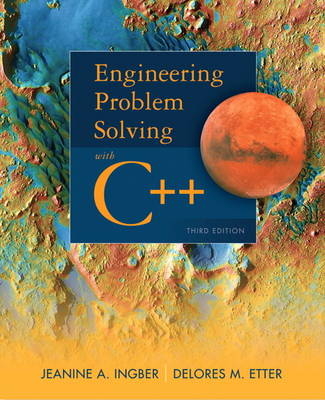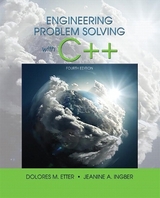
Engineering Problem Solving with C++
Pearson (Verlag)
978-0-13-249265-2 (ISBN)
- Titel erscheint in neuer Auflage
- Artikel merken
This text is a clear, concise introduction to problem solving and the C++ programming language. The authors’ proven five-step problem solving methodology is presented and then incorporated in every chapter of the text. Outstanding engineering and scientific applications are used throughout; all applications are centered around the theme of engineering challenges in the 21st century.
Dr. Delores M. Etter has been widely recognized for her innovative textbooks in problem solving for engineering and science students. She is currently holds the Texas Instruments Distinguished Chair in Engineering Education at Southern Methodist University in Dallas, TX. She has been a member of the Electrical and Computing Engineering faculties at the United States Naval Academy, the University of Colorado, Boulder, and the University of New Mexico. She was also a Visiting Professor at Stanford University. Dr. Etter is a member of the National Academy of Engineering , a fellow of IEEE, AAAS, and ASEE, and a former member of the National Science Board. Jeanine A. Ingber is currently the Chief Technical Officer of ASAP, LLC, a limited liability company founded in 2009 that develops numerical solutions to application problems in engineering and physics. She has held faculty positions at Iowa State University and the University of New Mexico and has received numerous teaching honors.
Preface xiii
1 Introduction to Computing and Engineering
Problem Solving 2
1.1 Historical Perspective 3
1.2 Recent Engineering Achievements 7
Changing Engineering Environment 9
1.3 Computing Systems 11
Computer Hardware 11
Computer Software 12
1.4 Data Representation and Storage 16
Number Systems 17
Data Types and Storage 23
1.5 An Engineering Problem-Solving Methodology 26
Summary 29
2 Simple C++ Programs 34
ENGINEERING CHALLENGE: Vehicle Performance
2.1 Program Structure 35
2.2 Constants and Variables 39
Scientific Notation 41
Numeric Data Types 42
Boolean Data Type 44
Character Data Type 44
String Data 46
Symbolic Constants 47
2.3 C++ Classes 48
Class Declaration 48
Class Implementation 49
2.4 C++ Operators 52
Assignment Operator 52
Arithmetic Operators 54
Precedence of Operators 56
Overflow and Underflow 58
Increment and Decrement Operators 59
Abbreviated Assignment Operators 60
2.5 Standard Input and Output 61
The cout Object 61
Stream Objects 62
Manipulators 64
The cin Object 67
2.6 Building C++ Solutions with IDEs: NetBeans 69
NetBeans 69
2.7 Basic Functions Included in the C++ Standard Library 76
Elementary Math Functions 77
Trigonometric Functions 78
Hyperbolic Functions* 80
Character Functions 81
2.8 Problem Solving Applied: Velocity Computation 81
2.9 System Limitations 85
Summary 86
3 Control Structures: Selection 94
ENGINEERING CHALLENGE: Global Change
3.1 Algorithm Development 95
Top-Down Design 95
3.2 Structured Programming 97
Pseudocode 97
Evaluation of Alternative Solutions 99
3.3 Conditional Expressions 99
Relational Operators 99
Logical Operators 100
Precedence and Associativity 103
3.4 Selection Statements: if Statement 104
Simple if Statements 104
if/else Statement 107
3.5 Numerical Technique: Linear Interpolation 111
3.6 Problem Solving Applied: Freezing Temperature of Seawater 115
3.7 Selection Statements: switch Statement 119
3.8 Building C++ Solutions with IDEs: NetBeans 122
NetBeans 122
3.9 Defining Operators for Programmer-Defined Data Types 128
Summary 133
4 Control Structures: Repetition 138
ENGINEERING CHALLENGE: Data Collection
4.1 Algorithm Development 139
Pseudocode and Flowchart Description 140
4.2 Repetition Structures 140
while Loop 141
do/while Loop 145
for Loop 148
4.3 Problem Solving Applied: GPS 153
4.4 break and continue Statements 157
4.5 Structuring Input Loops 158
Counter-Controlled Loops 158
Sentinel-Controlled Loop 160
End-Of-Data Loop 161
4.6 Problem Solving Applied: Weather Balloons 163
4.7 Building C++ Solutions with IDEs: Microsoft Visual C++ 168
Microsoft Visual C++ 170
Summary 174
5 Working with Data Files 180
ENGINEERING CHALLENGE: Weather Prediction
5.1 Defining File Streams 181
Stream Class Hierarchy 181
ifstream Class 184
ofstream Class 185
5.2 Reading Data Files 187
Specified Number of Records 188
Trailer or Sentinel Signals 190
End-of-File 192
5.3 Generating a Data File 195
5.4 Problem Solving Applied: Data Filters—Modifying an HTML File 198
5.5 Error Checking 202
The Stream State 203
5.6 Numerical Technique: Linear Modeling* 208
5.7 Problem Solving Applied: Ozone Measurements* 211
Summary 217
6 Modular Programming with Functions 224
ENGINEERING CHALLENGE: Simulation
6.1 Modularity 225
6.2 Programmer-Defined Functions 228
Function Definition 231
Solution 1 234
Solution 2 235
Function Prototype 238
6.3 Parameter Passing 239
Pass by Value 240
Pass by Reference 242
Storage Class and Scope 248
6.4 Problem Solving Applied: Calculating a Center of Gravity 250
6.5 Random Numbers 254
Integer Sequences 254
Floating-Point Sequences 258
6.6 Problem Solving Applied: Instrumentation Reliability 259
6.7 Defining Class Methods 266
Public Interface 267
Accessor Methods 268
Mutator Methods 269
6.8 Problem Solving Applied: Design of Composite Materials 274
Solution 1 276
Solution 2 277
6.9 Numerical Technique: Roots of Polynomials* 280
Polynomial Roots 280
Incremental-Search Technique 282
6.10 Problem Solving Applied: System Stability* 284
Newton—Raphson Method* 290
6.11 Numerical Technique: Integration* 293
Integration Using the Trapezoidal Rule 293
Summary 297
7 One-Dimensional Arrays 308
ENGINEERING CHALLENGE: Tsunami Warning Systems
7.1 Arrays 309
Definition and Initialization 310
Pseudocode 312
Computation and Output 315
Function Arguments 319
7.2 Problem Solving Applied: Hurricane Categories 324
7.3 Statistical Measurements 330
Simple Analysis 330
Variance and Standard Deviation 332
Custom Header Files 335
7.4 Problem Solving Applied: Speech Signal Analysis 335
7.5 Sorting and Searching Algorithms 341
Selection Sort 342
Search Algorithms 343
Unordered Lists 344
Ordered Lists 344
7.6 Problem Solving Applied: Tsunami Warning Systems 346
7.7 Character Strings 352
C Style String Definition and I/O 352
String Functions 354
7.8 The string Class 355
7.9 The vector class 357
Parameter Passing 360
7.10 Problem Solving Applied: Calculating Probabilities 362
Summary 375
8 Two-Dimensional Arrays 382
ENGINEERING CHALLENGE: Terrain Navigation
8.1 Two-Dimensional Arrays 383
Declaration and Initialization 384
Computations and Output 389
Function Arguments 392
8.2 Problem Solving Applied: Terrain Navigation 398
8.3 Two-Dimensional Arrays and the vector class 403
Function Arguments 406
8.4 Matrices 407
Determinant 407
Transpose 408
Matrix Addition and Subtraction 409
Matrix Multiplication 410
8.5 Numerical Technique: Solution to Simultaneous Equations 412
Graphical Interpretation 412
Gauss Elimination 416
8.6 Problem Solving Applied: Electrical Circuit Analysis 418
8.7 Higher Dimensional Arrays 424
Summary 426
9 An Introduction to Pointers 434
ENGINEERING CHALLENGE: Weather Patterns
9.1 Addresses and Pointers 435
Address Operator 436
Pointer Assignment 438
Pointer Arithmetic 441
9.2 Pointers to Array Elements 444
One-Dimensional Arrays 445
Character Strings 447
Pointers as Function Arguments 448
9.3 Problem Solving Applied: El Ni˜no-Southern Oscillation Data 453
9.4 Dynamic Memory Allocation 456
The new Operator 456
Dynamically Allocated Arrays 458
The delete Operator 458
9.5 Problem Solving Applied: Seismic Event Detection 460
9.6 Common Errors Using new and delete 466
9.7 Linked Data Structures 468
Linked Lists 468
Stacks 470
Queue 470
9.8 The C++ Standard Template Library 472
The list class 472
The stack class 474
The queue class 475
9.9 Problem Solving Applied: Concordance of a Text File 477
Summary 482
10 Advanced Topics 488
ENGINEERING CHALLENGE: Artificial Intelligence
10.1 Generic Programming 489
Function Templates 490
10.2 Data Abstraction 494
Overloading Operators 494
The Pixel class 495
Arithmetic Operators 496
friend Functions 501
Validating Objects 506
Bitwise Operators 510
10.3 Problem Solving Applied: Color Image Processing 513
10.4 Recursion 519
Factorial Function 520
Fibonacci Sequence 522
The BinaryTree class 524
10.5 Class Templates 536
10.6 Inheritance 542
The Rectangle class 542
The Square class 545
The Cube class 548
10.7 virtual Methods 551
10.8 Problem Solving Applied: Iterated Prisoner’s Dilemma 554
Summary 563
A C++ Standard Library 568
B ASCII Character Codes 576
C Using MATLAB to Plot Data from ASCII Files 580
C++ Program to Generate a Data File 580
ASCII Data File Generated by the C++ Program 581
Generating a Plot with MATLAB 581
D References 583
E PRACTICE! Solutions 584
Index 601
| Erscheint lt. Verlag | 30.1.2012 |
|---|---|
| Sprache | englisch |
| Maße | 187 x 232 mm |
| Gewicht | 820 g |
| Themenwelt | Mathematik / Informatik ► Informatik ► Programmiersprachen / -werkzeuge |
| Informatik ► Software Entwicklung ► Objektorientierung | |
| Technik ► Maschinenbau | |
| ISBN-10 | 0-13-249265-2 / 0132492652 |
| ISBN-13 | 978-0-13-249265-2 / 9780132492652 |
| Zustand | Neuware |
| Informationen gemäß Produktsicherheitsverordnung (GPSR) | |
| Haben Sie eine Frage zum Produkt? |
aus dem Bereich



